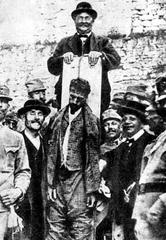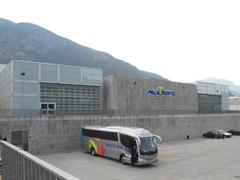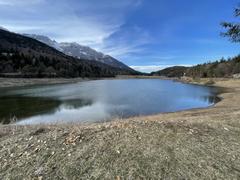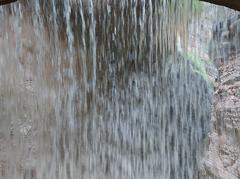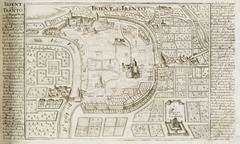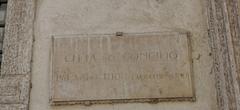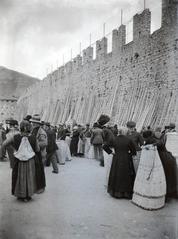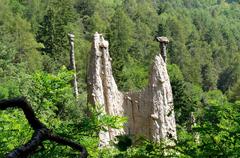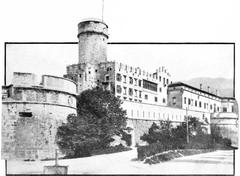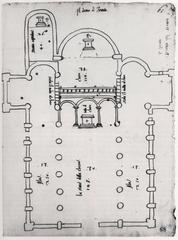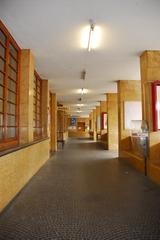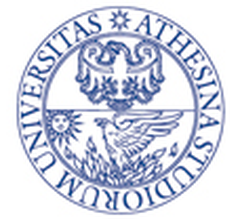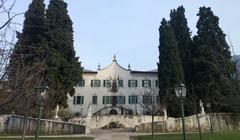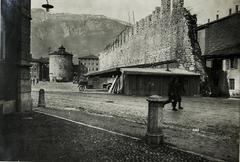Forte di Mezzo Visiting Hours, Tickets, and Guide to Trento Historical Sites
Date: 14/06/2025
Introduction
Forte di Mezzo, perched in the scenic Trentino-Alto Adige/Südtirol region of northern Italy, is a striking example of late 19th and early 20th-century military architecture and a key piece of the region’s cultural heritage. Originally constructed by the Austro-Hungarian Empire, the fort was part of a sophisticated defensive network to safeguard the Adige Valley and approaches to Lake Garda—a strategic position during World War I. Today, Forte di Mezzo stands not only as a preserved military monument but also as a vibrant site for history, culture, and panoramic Alpine views.
This comprehensive guide provides detailed information about Forte di Mezzo’s historical context, architectural highlights, restoration efforts, visitor logistics, and cultural programming. Whether you are planning a historical exploration, searching for stunning vistas, or seeking engaging educational experiences, Forte di Mezzo offers a multifaceted journey into Trentino’s past. For up-to-date planning, consult official resources such as Musei Online, Garda Trentino Official Site, and the Forte Belvedere official site.
Contents
- Introduction
- Historical Background and Significance
- Restoration and Conservation Efforts
- Visitor Information
- Visiting Hours and Seasonal Availability
- Tickets and Admission Prices
- Accessibility and Transportation
- Guided Tours and Special Events
- Architectural Highlights and Features
- Nearby Attractions and Related Fortifications
- Practical Visitor Tips
- Visuals and Media Resources
- Frequently Asked Questions (FAQ)
- Conclusion
Historical Background and Significance
Austro-Hungarian Military Role
Forte di Mezzo, also known as “Batteria Alta” or “Obere Batterie,” was built between 1898 and 1900 as part of the Austro-Hungarian Empire’s third-generation mountain fortifications. Its strategic position on Monte Brione, near Riva del Garda and south of Trento, provided control over the Adige Valley and key regional routes. The fort was central to the defense network during World War I, with its garrison monitoring enemy movements and protecting vital access points (Musei Online).
Architectural Heritage
Constructed from local stone and reinforced concrete, Forte di Mezzo features thick sloped walls, underground tunnels, armored gun turrets, and advanced water management systems. Its design reflects the era’s technological advancements, prioritizing both defensive resilience and operational functionality (ISPRS Archives).
Transformation into a Site of Remembrance
After its decommissioning, Forte di Mezzo transitioned from an active military post to a site of historical education and remembrance. It is now part of the Sentiero della Pace (Peace Trail), connecting World War I heritage sites throughout Trentino. The fort’s preservation allows visitors to engage with the region’s complex history and reflect on the legacy of conflict and reconciliation.
Restoration and Conservation Efforts
Recent restoration projects led by the Provincia Autonoma di Trento and the Comune di Riva del Garda have focused on stabilizing the fort’s structure, reinforcing walls, and restoring artillery emplacements and tunnels. These efforts ensure visitor safety while preserving historical authenticity. Integration with the Sentiero della Pace has also enhanced accessibility, linking Forte di Mezzo with neighboring forts like Forte Garda and San Nicolò Fort. Adaptive reuse initiatives have transformed nearby casemates into visitor shelters and event spaces, supporting educational programs and community events.
Visitor Information
Visiting Hours and Seasonal Availability
Forte di Mezzo (Mattarello/Riva del Garda):
- Open from April through October, Thursday to Sunday, 10:00–18:00.
- Check official tourism websites for seasonal updates and special event openings.
Forte di Mezzo (Lavarone/Forte Belvedere-Gschwent):
- Operates with extended summer hours and limited winter access. As of 2025:
- January: 2nd–6th, 10:00–16:00
- February: By reservation (min. 20 participants)
- March: 1st–5th, 10:00–17:00
- April–May: Weekends and select holidays, 10:00–18:00
- June: Tuesday–Sunday, 10:00–18:00
- July–August: Daily, 10:00–18:00
- September–October: Weekends, 10:00–18:00
- November–December: Limited dates, 10:00–16:00 or 10:00–17:00
- Last admission: 30 minutes before closing.
- Weather and road conditions may affect access; always check the official site before visiting.
Tickets and Admission Prices
- Mattarello/Riva del Garda: Around €5 for adults; discounts for children, seniors, and groups. Entry may be free or included in guided tour packages—verify with local organizers.
- Lavarone (Forte Belvedere-Gschwent):
- Adults: €8
- Reduced: €6 (over 65, ages 7–17, groups, armed forces, convention groups)
- Family ticket: €18 (two parents + one child under 18; extra children free)
- Free: Under 7, Guest Card holders, disabled visitors (+1 companion), teachers/chaperones
- Guided tours (min. 20 participants): €8/person, reservation required
- School classes: €3.50/student
- Guest Card holders: €3
- Tickets are available on-site and may be reserved in advance for groups and tours (Forte Belvedere official site).
Accessibility and Transportation
- Mattarello: Reachable by car (parking available), local bus, bicycle, or on foot via marked trails.
- Lavarone: Easily accessible by car; regional buses connect to Trento (schedules limited outside peak season). Ample parking is provided.
- Some areas have uneven terrain and stairs; contact local offices for specific accessibility accommodations.
Guided Tours and Special Events
- Guided tours are available in multiple languages and are highly recommended for a richer historical and architectural understanding.
- Tours last around 1–1.5 hours, often requiring advance booking—especially for groups.
- Seasonal events include historical reenactments, educational workshops, and temporary exhibitions. Check event calendars on official websites.
Architectural Highlights and Features
Explore robust stonework, reinforced concrete structures, underground galleries, armored gun turrets, and panoramic observation posts. Key features include:
- Thick sloped defensive walls and camouflaged emplacements
- Field kitchens, officers’ quarters, and original artillery platforms
- Tunnels and secure passages constructed for troop movement and observation
- Panoramic views over the Adige Valley, Lake Garda, and surrounding Alpine landscapes
Nearby Attractions and Related Fortifications
Take advantage of the region’s rich military and cultural heritage by visiting:
- Other Monte Brione forts: Forte Garda, Forte San Nicolò
- In Trento: Museo Storico Italiano della Guerra, Castello del Buonconsiglio, MUSE – Science Museum
- Around Lavarone: Circuito dei Forti del Trentino, Monte Bondone, Altopiano di Piné
- Outdoor activities: Hiking, cycling, and winter sports in the surrounding mountains
Practical Visitor Tips
- Wear sturdy, comfortable footwear for uneven terrain.
- Bring water and snacks; on-site facilities may be limited.
- Dress in layers; inside the stone fort can be cool and damp.
- Check weather and road conditions, especially in winter or early spring.
- Photography is allowed, but flash/tripod use may be restricted in exhibitions.
- Pets are generally not allowed inside the fort.
Visuals and Media Resources
Find galleries of high-quality images—showcasing stone walls, artillery platforms, tunnels, and panoramic views—on official tourism and fort websites. For enhanced SEO, use alt tags like “Forte di Mezzo panoramic view Lake Garda” or “Historic fortification walls Trento.” Interactive maps and virtual tours are also recommended for planning and engagement.
Frequently Asked Questions (FAQ)
Q: What are the current visiting hours?
A: Hours vary by season and location. Typically, from April/June to October, 10:00–18:00. Always check the official site for updates.
Q: How much does admission cost?
A: Tickets range from free to €8, depending on location, age, and tour type. Family and group discounts are available.
Q: Is Forte di Mezzo accessible for people with disabilities?
A: Some areas are accessible, but terrain and stairs present challenges. Contact the site in advance for details.
Q: Are guided tours available?
A: Yes, in several languages; advance booking is recommended, especially for groups.
Q: Is parking available?
A: Yes, at both main locations.
Q: Can I bring my pet?
A: Pets are generally not permitted inside the fort.
Conclusion
Forte di Mezzo is a compelling destination for anyone interested in history, architecture, and natural beauty. Its well-preserved military structures, ongoing conservation, and educational programming make it a highlight of Trentino’s cultural landscape. Whether exploring on your own or joining a guided tour, you’ll gain insight into the region’s pivotal role in European history and enjoy sweeping Alpine vistas.
Maximize your visit by checking current hours and ticketing options on official websites, preparing for terrain and weather, and considering the Audiala app for enhanced guided experiences. Embrace the opportunity to connect with a chapter of European history—amidst the stunning backdrop of the Italian Alps.
Further Resources & Official Links
- Musei Online
- Garda Trentino Official Site
- Forte Belvedere official site
- Viaggiando Italia
- Visit Trentino
- MAG Museo Alto Garda
- Alpini Mattarello
- MUSE – Science Museum of Trento
- Trento Tourist Office

